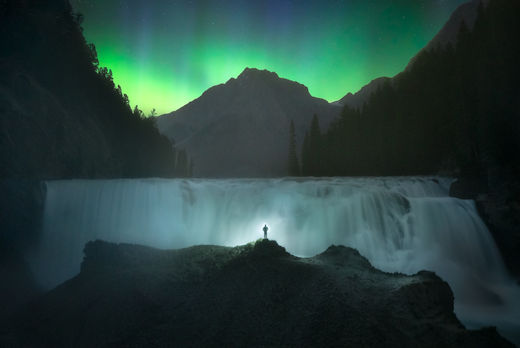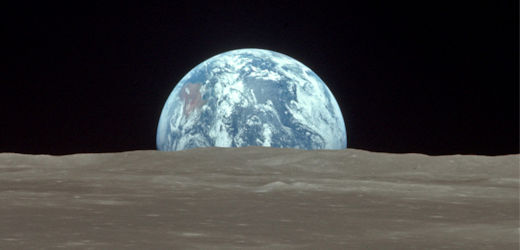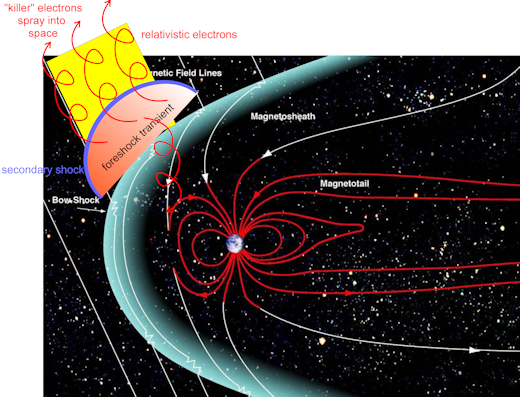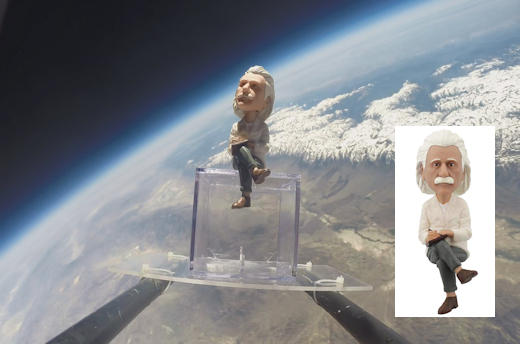Special Offer: SAVE 600nok per person. Book a combination aurora borealis chase and scenic day tour during the months of September, October or November 2019 for the special price of 1800 kr. Check Marianne's webpage for details! | | |
BRIGHT JUPITER-MOON CONJUNCTION: When the sun goes down tonight, step outside and look south. The waxing gibbous Moon is approaching Jupiter for a beautiful conjunction alongside the red giant star Antares. At closest approach on Friday, Aug. 9th, Jupiter and the Moon will be only a few degrees apart. If you can, catch them before the evening sky fades to black. A bright conjunction framed by twilight blue is extra-beautiful. Sky map: August 9. Browse: photo gallery.
AURORA FALLS: On August 5th, a fast-moving stream of solar wind hit Earth's magnetic field. Paul Zizka was at Wapta Falls in British Columbia when the sky overhead turned green:

"This is a self-portrait taken during the fabulous display we had a few nights ago-our first significant auroras in several months here in the Canadian Rockies," says Zizka.
Another stream of solar wind is approaching Earth. Estimated time of arrival: Aug. 10-11. The incoming stream is flowing from a southern hole in the sun's atmosphere. It is not as potent as the solar wind stream of August 5th, but still could spark auroras over Canada and other high-latitude locations. Aurora alerts: SMS Text.
Realtime Aurora Photo Gallery
Free: Spaceweather.com Newsletter
A NEW SOURCE OF SPACE RADIATION: Astronauts are surrounded by danger: hard vacuum, solar flares, cosmic rays. Researchers from UCLA have just added a new item to the list. Earth itself.
“A natural particle accelerator only 40,000 miles above Earth’s surface is producing ‘killer electrons’ moving close to the speed of light,” says Terry Liu, a newly-minted PhD who studied the phenomenon as part of his thesis with UCLA Prof. Vassilis Angelopoulos.
This means that astronauts leaving Earth for Mars could be peppered by radiation coming at them from behind–from the direction of their own home planet.

NASA’s THEMIS spacecraft ran across the particles in 2008 not far from the place where the solar wind slams into Earth’s magnetic field. Researchers have long known that shock waves at that location could accelerate particles to high energies–but not this high. The particles coming out of the Earth-solar wind interface have energies up to 100,000 electron volts, ten times greater than previously expected.
How is this possible? Liu found the answer by combining THEMIS data with computer simulations of the sun-Earth interface. When the solar wind meets Earth, it forms a shock wave around Earth’s magnetic field, shaped like the bow waves that form ahead of a boat moving through water. Within this “bow shock” immense stores of energy can be abruptly released akin to the sonic boom of an airplane.
Liu found that some electrons are shocked not just once, but twice or more, undergoing mirror-like reflections within the bow shock that build energy to unexpected levels. Most of the boosted particles shoot back into space away from Earth.

Above: Dr. Terry Liu created this diagram showing the location of the natural particle accelerator and how it sprays radiation into space.
“Similar particles have been detected near Saturn, suggesting that the process is at work there as well,” says Liu. “Indeed,” adds Angelopoulos, “this type of particle acceleration could be happening throughout the cosmos–from supernovas to solar storms–wherever a supersonic wind hits a barrier.”
Meanwhile, back home, Earth-orbiting satellites and departing astronauts have a new source of radiation to contend with. It’s right over their shoulder.
Read the original research at Science Advances.
THIS GIFT IS GENIOUS: What would Einstein think!? On June 8, 2019, the students of Earth to Sky Calculus launched a cosmic ray balloon to the stratosphere. This Albert Einstein bobblehead went along for the ride:

Albert contemplated the curve of the Earth for almost 3 hours as the balloon ascended 111,222 feet above the Sierra Nevada Mountains of central California.
You can have him for $66.74--that is, 10 times the gravitational constant, G. The students are selling these bobbleheads to support their cosmic ray ballooning program. They make great novelty gifts! Each one comes with a greeting card showing the item in flight and telling the story of its journey to the edge of space.
Far Out Gifts: Earth to Sky Store
All sales support hands-on STEM education
Realtime Space Weather Photo Gallery
Free: Spaceweather.com Newsletter
Every night, a network of
NASA all-sky cameras scans the skies above the United States for meteoritic fireballs. Automated software maintained by NASA's Meteoroid Environment Office calculates their orbits, velocity, penetration depth in Earth's atmosphere and many other characteristics. Daily results are presented here on Spaceweather.com.
On Aug. 9, 2019, the network reported 31 fireballs.
(17 sporadics, 14 Perseids)

In this diagram of the inner solar system, all of the fireball orbits intersect at a single point--Earth. The orbits are color-coded by velocity, from slow (red) to fast (blue). [Larger image] [movies]
Potentially Hazardous Asteroids (
PHAs) are space rocks larger than approximately 100m that can come closer to Earth than 0.05 AU. None of the known PHAs is on a collision course with our planet, although astronomers are finding
new ones all the time.
On August 9, 2019 there were 1983 potentially hazardous asteroids.
 |
Recent & Upcoming Earth-asteroid encounters: | Asteroid | Date(UT) | Miss Distance | Velocity (km/s) | Diameter (m) |
| 2019 PT | 2019-Aug-05 | 4.5 LD | 6.2 | 23 |
| 2019 PC1 | 2019-Aug-06 | 2.2 LD | 13.2 | 22 |
| 2019 PU | 2019-Aug-07 | 8.3 LD | 6 | 24 |
| 2019 PH1 | 2019-Aug-07 | 2.1 LD | 16.6 | 38 |
| 2006 QQ23 | 2019-Aug-10 | 19.4 LD | 4.7 | 339 |
| 454094 | 2019-Aug-12 | 17 LD | 8.2 | 148 |
| 2019 PX | 2019-Aug-12 | 19.6 LD | 12 | 35 |
| 2019 PJ | 2019-Aug-16 | 8.8 LD | 14.2 | 59 |
| 2018 PN22 | 2019-Aug-17 | 17.1 LD | 2.3 | 11 |
| 2019 PK | 2019-Aug-18 | 11 LD | 7.4 | 31 |
| 2016 PD1 | 2019-Aug-26 | 11.3 LD | 5.9 | 65 |
| 2002 JR100 | 2019-Aug-27 | 19.4 LD | 8.4 | 49 |
| 2019 OU1 | 2019-Aug-28 | 2.7 LD | 13.1 | 94 |
| 2019 OF2 | 2019-Sep-03 | 18.3 LD | 10.7 | 53 |
| 2018 DE1 | 2019-Sep-03 | 12.7 LD | 6.6 | 28 |
| 2019 GT3 | 2019-Sep-06 | 19.5 LD | 13.6 | 227 |
| 2010 RM82 | 2019-Sep-13 | 18.2 LD | 14.6 | 23 |
| 2013 CV83 | 2019-Sep-13 | 15.7 LD | 13.1 | 62 |
| 504800 | 2019-Sep-14 | 13.9 LD | 14.4 | 155 |
| 467317 | 2019-Sep-14 | 13.9 LD | 6.4 | 389 |
| 2019 JF1 | 2019-Sep-16 | 11.2 LD | 4.3 | 61 |
| 2018 FU1 | 2019-Sep-16 | 18.4 LD | 4.7 | 16 |
| 2017 SL16 | 2019-Sep-21 | 7.9 LD | 6.5 | 25 |
| 2017 SM21 | 2019-Sep-21 | 11.5 LD | 9.6 | 20 |
| 2006 QV89 | 2019-Sep-23 | 15.9 LD | 4.2 | 31 |
| 523934 | 2019-Sep-24 | 10.9 LD | 22.3 | 257 |
| 2017 KP27 | 2019-Sep-26 | 6.2 LD | 4.8 | 25 |
| 2018 FK5 | 2019-Oct-01 | 13.3 LD | 10.5 | 8 |
| 2018 LG4 | 2019-Oct-02 | 13.8 LD | 8.1 | 12 |
| 2017 TJ4 | 2019-Oct-05 | 13.5 LD | 8.9 | 32 |
Notes: LD means "Lunar Distance." 1 LD = 384,401 km, the distance between Earth and the Moon. 1 LD also equals 0.00256 AU. MAG is the visual magnitude of the asteroid on the date of closest approach. | | Cosmic Rays in the Atmosphere |
SOMETHING NEW! We have developed a new predictive model of aviation radiation. It's called E-RAD--short for Empirical RADiation model. We are constantly flying radiation sensors onboard airplanes over the US and and around the world, so far collecting more than 22,000 gps-tagged radiation measurements. Using this unique dataset, we can predict the dosage on any flight over the USA with an error no worse than 15%.
E-RAD lets us do something new: Every day we monitor approximately 1400 flights criss-crossing the 10 busiest routes in the continental USA. Typically, this includes more than 80,000 passengers per day. E-RAD calculates the radiation exposure for every single flight.
The Hot Flights Table is a daily summary of these calculations. It shows the 5 charter flights with the highest dose rates; the 5 commercial flights with the highest dose rates; 5 commercial flights with near-average dose rates; and the 5 commercial flights with the lowest dose rates. Passengers typically experience dose rates that are 20 to 70 times higher than natural radiation at sea level.
To measure radiation on airplanes, we use the same sensors we fly to the stratosphere onboard Earth to Sky Calculus cosmic ray balloons: neutron bubble chambers and X-ray/gamma-ray Geiger tubes sensitive to energies between 10 keV and 20 MeV. These energies span the range of medical X-ray machines and airport security scanners.
Column definitions: (1) The flight number; (2) The maximum dose rate during the flight, expressed in units of natural radiation at sea level; (3) The maximum altitude of the plane in feet above sea level; (4) Departure city; (5) Arrival city; (6) Duration of the flight.
SPACE WEATHER BALLOON DATA: Approximately once a week, Spaceweather.com and the students of Earth to Sky Calculus fly space weather balloons to the stratosphere over California. These balloons are equipped with radiation sensors that detect cosmic rays, a surprisingly "down to Earth" form of space weather. Cosmic rays can seed clouds, trigger lightning, and penetrate commercial airplanes. Furthermore, there are studies ( #1, #2, #3, #4) linking cosmic rays with cardiac arrhythmias and sudden cardiac death in the general population. Our latest measurements show that cosmic rays are intensifying, with an increase of more than 18% since 2015:

The data points in the graph above correspond to the peak of the Reneger-Pfotzer maximum, which lies about 67,000 feet above central California. When cosmic rays crash into Earth's atmosphere, they produce a spray of secondary particles that is most intense at the entrance to the stratosphere. Physicists Eric Reneger and Georg Pfotzer discovered the maximum using balloons in the 1930s and it is what we are measuring today.
En route to the stratosphere, our sensors also pass through aviation altitudes:

In this plot, dose rates are expessed as multiples of sea level. For instance, we see that boarding a plane that flies at 25,000 feet exposes passengers to dose rates ~10x higher than sea level. At 40,000 feet, the multiplier is closer to 50x.
The radiation sensors onboard our helium balloons detect X-rays and gamma-rays in the energy range 10 keV to 20 MeV. These energies span the range of medical X-ray machines and airport security scanners.
Why are cosmic rays intensifying? The main reason is the sun. Solar storm clouds such as coronal mass ejections (CMEs) sweep aside cosmic rays when they pass by Earth. During Solar Maximum, CMEs are abundant and cosmic rays are held at bay. Now, however, the solar cycle is swinging toward Solar Minimum, allowing cosmic rays to return. Another reason could be the weakening of Earth's magnetic field, which helps protect us from deep-space radiation.
| | The official U.S. government space weather bureau |
| | The first place to look for information about sundogs, pillars, rainbows and related phenomena. |
| | Researchers call it a "Hubble for the sun." SDO is the most advanced solar observatory ever. |
| | 3D views of the sun from NASA's Solar and Terrestrial Relations Observatory |
| | Realtime and archival images of the Sun from SOHO. |
| | from the NOAA Space Environment Center |
| | fun to read, but should be taken with a grain of salt! Forecasts looking ahead more than a few days are often wrong. |
| | from the NOAA Space Environment Center |
| | the underlying science of space weather |
 | To find reviews of new online casino sites in the UK try The Casino DB where there are hundreds of online casino reviews complete with bonuses and ratings. Looking for a new online casino? Try Casimpo the new site dedicated to making online casino simple and easy for all. |
| | These links help Spaceweather.com stay online. Thank you to our supporters! |
| | | | | | |

